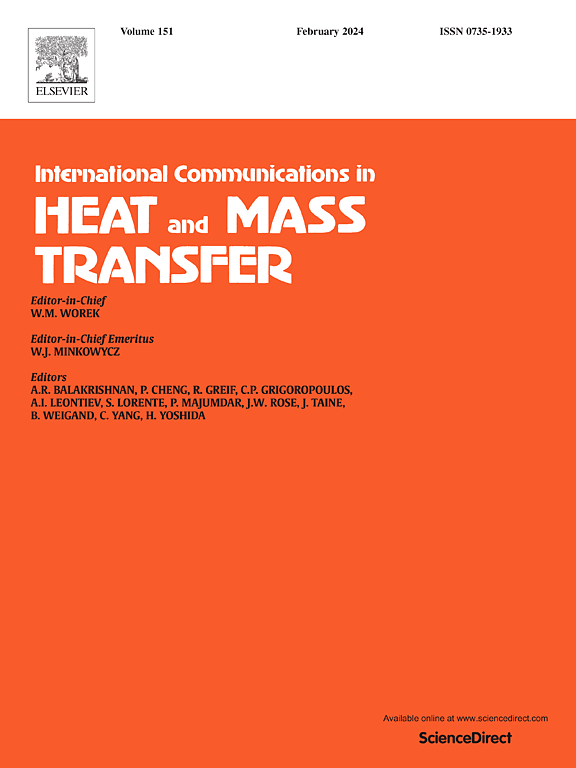Verification and validation plus uncertainty quantification of heat transfer simulation for liquid metal in wire-wrapped rod assembly
IF 6.4
2区 工程技术
Q1 MECHANICS
International Communications in Heat and Mass Transfer
Pub Date : 2025-05-24
DOI:10.1016/j.icheatmasstransfer.2025.109114
引用次数: 0
Abstract
A complete CFD best practice process is proposed, including Phenomena Identification and Ranking Table (PIRT), Verification and Validation (V&V), and Uncertainty Quantification (UQ). The heat transfer of liquid metal within a rod assembly under both normal and blocked conditions is used as an example to demonstrate the full CFD process. Key flow and heat transfer phenomena are identified, and model sensitivity analyses are performed based on these phenomena. Turbulent Prandtl models, porous blockage models and different meshing strategies sensitivity analysis are conducted. Uncertainty quantification is performed. The discretization uncertainty is calculated using the Grid Convergence Index (GCI). The convergence orders are greater than unity for all cases except the fluid temperature in the blocked condition using meshing strategy 2. The input parameter uncertainty is estimated using finite difference. The model uncertainty is derived. Under normal condition, the model uncertainty of the wall and fluid temperatures are 2.88 K and 3.37 K, respectively. Under blocked condition, the model uncertainty of wall temperature is slightly higher than fluid temperature. The wall temperature uncertainty for strategies 1 and 2 are 8.46 K and 9.03 K, while the fluid uncertainty of strategy 1 and 2 are 3.57 K and 3.06 K, respectively.
线包棒组件中液态金属传热模拟的验证与验证及不确定度量化
提出了一个完整的CFD最佳实践流程,包括现象识别和排位表(PIRT)、验证和验证(V&;V)和不确定度量化(UQ)。以正常工况和阻塞工况下的棒组内液态金属传热为例,对整个CFD过程进行了验证。识别了关键的流动和传热现象,并基于这些现象进行了模型灵敏度分析。对湍流普朗特模型、多孔堵塞模型和不同网格划分策略进行了灵敏度分析。进行不确定度量化。采用网格收敛指数(GCI)计算离散化不确定性。在网格划分策略2中,除流体温度在阻塞条件下外,其他情况的收敛阶数均大于1。用有限差分法估计输入参数的不确定性。导出了模型的不确定性。在正常条件下,壁面温度和流体温度的模型不确定度分别为2.88 K和3.37 K。在封闭条件下,壁面温度的模型不确定性略高于流体温度。策略1和策略2的壁温不确定性分别为8.46 K和9.03 K,策略1和策略2的流体不确定性分别为3.57 K和3.06 K。
本文章由计算机程序翻译,如有差异,请以英文原文为准。
求助全文
约1分钟内获得全文
求助全文
来源期刊
CiteScore
11.00
自引率
10.00%
发文量
648
审稿时长
32 days
期刊介绍:
International Communications in Heat and Mass Transfer serves as a world forum for the rapid dissemination of new ideas, new measurement techniques, preliminary findings of ongoing investigations, discussions, and criticisms in the field of heat and mass transfer. Two types of manuscript will be considered for publication: communications (short reports of new work or discussions of work which has already been published) and summaries (abstracts of reports, theses or manuscripts which are too long for publication in full). Together with its companion publication, International Journal of Heat and Mass Transfer, with which it shares the same Board of Editors, this journal is read by research workers and engineers throughout the world.

 求助内容:
求助内容: 应助结果提醒方式:
应助结果提醒方式:


